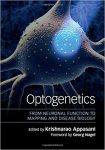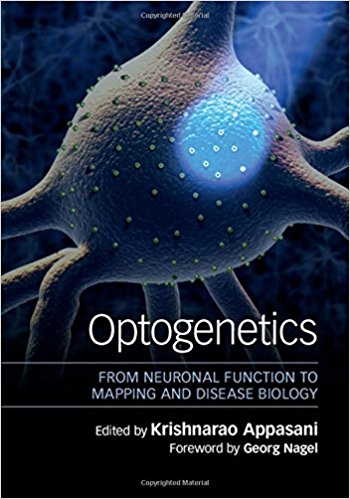 Editor: Krishnarao Appasani
Editor: Krishnarao Appasani
Publisher: Cambridge University Press – 476 pages
Book Review by: Nano Khilnani
This book published in 2017 is on the relatively new but rapidly expanding field of optogenetics,
What does this term mean?
“Optogenetics is a very simple and straight-forward concept: a genetically-encoded protein is activated by illumination,” writes Georg Nagel of the Julius-von Sachs Institute at the University of Wurzburg in Germany, author of the Foreword for this book.
Optogenetics (from the Greek optikós, meaning ‘seen, visible’) is a biological technique which involves the use of light to control cells in living tissue, typically neurons, that have been genetically modified to express light-sensitive ion channels. The key reagents used in optogenetics are light-sensitive proteins.
The term ‘optogenetics’ was first proposed for the light-induced depolarization of cells via Channelrhodopsin-2. Nagel points out. He explains: “earlier, very successful experiments with genetically-encoded green fluorescent protein (GFP) and the whole family of derivatives and fusion constructs could also certainly be included within optogenetics, in this case with optogentic sensors, whereas channelrhodopsins belong to optogentic activators.”
Seventy-six specialists in various aspects of optogenetics from all over the United States and 14 other countries – China, France, Germany, India, Israel, Italy, Japan, Mexico, Russia, South Korea, Spain, Sweden, Switzerland, and the United Kingdom – authored or coauthored the 32 chapters of this book. The chapters are allocated among six Parts that we list below:
- Optogenetics in Model Organisms
- Opsin Biology: Tools, and Technology Platform
- Optogentics in Neurobiology, Brain Circuits, and Plasticity
- Optogentics in Learning, Neuropsychiatric Diseases, and Behavior
- Optogentics in Vision Restoration and Memory
- Optogenetics in Sleep, Prosthetics, and Epigenetics of Neurodegenerative Diseases
Biochemists had, even prior to gene technology, the idea to use ultraviolet (UV) light as a trigger for biochemical or cell biological reactions, This might be called ‘optobiochemistry’ or ‘chemical optogenetics’, writes Nagel. With the latter he refers to synthesized light-sensitive reagents such as caged adenosine triphosphate (ATP) or caged neurotransmitters, and the ‘very successful family of compounds based on azobenzene.
“The goal is for this book to serve as a reference for graduate students, postdoctoral researchers and instructors, and as an explanatory analysis for executives and scientists in molecular medicine, molecular engineering, biotechnology, and pharmaceutical companies. Our hope is that this volume will serve as a prologue to the field for newcomers and as a reference for those already in the field,” write the editor Krishnarao Appasani and his associate Raghu K. Appasani in the Preface.
An important chapter to look at in this book is chapter 22, Optogenetics in Treating Retinal Disease, authored by Dasha Nedilova and Federico Esposti. This is one of six chapters (22 to to 27) in Part V, Optogentics in Vision Restoration and Memory.
In the Introduction to this chapter, the authors state: “the retina is our most complex sensory organ,” and that blindness often results from some dysfunction or another within the neural network of the retina. Degenerative diseases of the retina in particular, are incurable, and patients with one or more of these diseases suffer progressive visual decline from the ongoing loss of retinal cells.
Photoreceptors are particularly prone to degeneration. Despite photoreceptor loss however, Nedilova and Esposti point out that “downstream neural activity is often sufficiently intact to make prospective sight-restoring therapies feasible, if the appropriate cells can be made to respond to light.”
The chapter authors go on to make optimistic remarks: “One of the main goals of translational retinal research is to develop strategies to repair the retina. Given the great complexity of this tissue, any attempt to restore retinal function requires quantitative knowledge of retinal neural circuits, as well as methods to target these circuits effectively.”
This chapter has the following components:
22.1 – Introduction
22.2 – Retinal Circuits
22.3 – Emerging Therapeutic Options in Retinal Disease
22.4 – Optogenetic Considerations
22.4.1 – Targeting the Right Circuit Element
22.4.2 – Viral Delivery of Optogenetic Tools
22.4.3 – Selecting An Optogentic Tool
22.4.4 – Light Adaptation, Gain Control and Color
22.4.5 – ON and OFF Channels
22.4.6 – Image Distortion
22.5 – Conclusion
This is an excellent, pioneering work on a specialty within ophthalmology that is only about 10 years old. Research within it holds much promise, and we commend the editor and the authors of the chapters of this book for their effort in widening the frontiers of knowledge of optogenetics.
Editor:
Krishnarao Appasani is the founder and chief executive officer of GeneExpression Systems. He is an award-wining scientist, and the editor of numerous books including Genome-Wide Association Studies (2016) and Epigenomics (2012).







